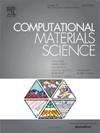Solidification of a quaternary X5CrNi18-10 alloy during laser beam welding using CALPHAD data in a phase-field approach
IF 3.1
3区 材料科学
Q2 MATERIALS SCIENCE, MULTIDISCIPLINARY
引用次数: 0
Abstract
Dendritic growth is a common phenomenon during the solidification of alloys, and it has a significant impact on the final microstructure and mechanical properties of the material. This research study investigates the solidification behaviour of quaternary X5CrNi18-10 alloys at thermochemical conditions similar to the laser beam welding (LBW) process. The aim of this investigation is to gain a comprehensive understanding of microstructure evolution at the microscale and their correlation with the macroscopic welding process conditions. To achieve this, a combined approach using the CALculation of PHAse Diagrams (CALPHAD) database and phase-field simulations is employed. Based on the CALPHAD-derived Gibbs energy functions, phase-field simulations are performed to simulate the solidification with dendritic/cellular morphology. The study focuses on solidification microstructure evolution influenced by process conditions such as thermal gradient and LBW velocity at steady-state conditions. By analysing the solidification microstructure morphology in 2D, valuable insights into the solidification kinetics and the influence of local thermal conditions on dendritic growth are obtained. Furthermore, the micro-segregation behaviour of key alloying elements during solidification in the mushy zone is explored. This study will help to enhance the understanding of dendritic solidification in this welding process, facilitating the optimisation of process parameters for improved mechanical properties.

求助全文
约1分钟内获得全文
求助全文
来源期刊

Computational Materials Science
工程技术-材料科学:综合
CiteScore
6.50
自引率
6.10%
发文量
665
审稿时长
26 days
期刊介绍:
The goal of Computational Materials Science is to report on results that provide new or unique insights into, or significantly expand our understanding of, the properties of materials or phenomena associated with their design, synthesis, processing, characterization, and utilization. To be relevant to the journal, the results should be applied or applicable to specific material systems that are discussed within the submission.
 求助内容:
求助内容: 应助结果提醒方式:
应助结果提醒方式:


